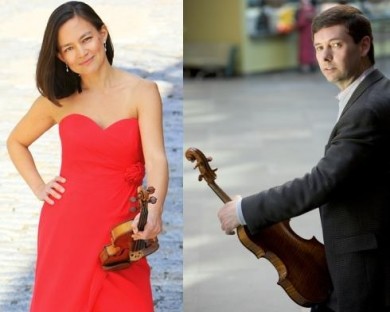New World members and guest artists spark chamber program of Mozart and Dvořák

Elissa Lee Koljonen and Roberto Diaz joined New World Symphony members for Sunday’s chamber music program.
Visits from the violist Roberto Díaz have long enriched South Florida’s musical culture.
Díaz, president of the Curtis Institute of Music, the Philadelphia conservatory that plays Yale to Juilliard’s Harvard, performs frequently in South Florida chamber concerts and has served as a coach for the young musicians of the New World Symphony.
He appeared Sunday at New World Center in Miami Beach with his wife, the violinist Elissa Lee Koljonen, in an energetic—at times, too energetic—-performance of Mozart’s Sinfonia Concertante with the New World Symphony, shrunken for the occasion to 18th-century proportions.
In composing the work, Mozart treated the two solo instruments as equals, rather than subordinating the viola to its treble clef partner. But equal does not mean identical, and in their performance Sunday the two soloists made little effort to sound like echoes of each other, making for a more dramatic, if not always polished, performance.
Violinist Koljonen played in a precise and delicate manner, with a sweet but spindly tone that seemed made for the Classical era. Díaz took a more aggressive approach, thundering down the lower strings of his dark-hued instrument and tearing through passages with heavy, jackhammer-like bow strokes, particularly in the first movement.
There’s no question that Díaz’s approach added excitement to the performance, but the playing sometimes seemed too heavy for Mozart. The second movement was free of this approach, a moving interlude in which the two soloist engaged in a grave dialogue that built to tremendous intensity. The third was light and high spirited, giving the performance a jovial ending.
In true concertante style, the two soloists played with their respective sections in the strictly orchestral passages. Díaz sort of conducted, giving a few gestures with his head and hands. But for the most part, the orchestral musicians were on their own, and they acquitted themselves well, delivering a disciplined and surprisingly symphonic performance for the modest forces on stage. Horns and winds gave virtually immaculate performances, blending in with the strings and adding luster to the orchestral tone.
After intermission, five members of New World came on stage for Dvořák’s String Quintet No. 2 in G Major. The work is unusual in calling for a double bass, rather than an extra viola or cello, as the fifth instrument. As was effectively demonstrated in a short talk by cellist Carl Baron, who had the performers play a passage with and without the bass, the huge string instrument adds tremendously to the depth and resonance of the ensemble. And throughout the performance bass Charles Clement wielded the power of his instrument effectively, displayed a deft and light touch when necessary, and never overpowering the other instruments.
The musicians mustered the propulsive force required in the fiery passages with which the work abounds, yet relaxed and gave the music room to breathe in lyric passages that recalled the chamber works of Schubert. In rustic, folk-like sections, such as the theme of the Scherzo, they played with vigor without any sacrifice of polish. First violinist Sunjoo Park brought a tone of warmth and sweetness to the delicate melody of the third movement, moving seamlessly and easily up the violin’s highest string.
Posted in Performances
One Response to “New World members and guest artists spark chamber program of Mozart and Dvořák”
Leave a Comment
Mon Apr 15, 2013
at 2:06 am
1 Comment







Posted Apr 16, 2013 at 8:38 pm by Matthew Carone
I’m an artist and a violinist. Your criticism of the Mozart Symphonie Concertante leads me to believe that you’re not a violinist.
My opinion is diametrically opposed to yours. It was extremely heart warming in that their interpretations did not resemble other wonderful performances that I have heard. It was dialogue between a loving wife and a strong husband each expressing their passion for each other. It was opera it was soprano and tenor it was musicianship on the highest level full of sweetness and drama.